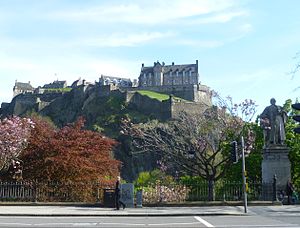Castle Rock, Edinburgh
| Castle Rock | |||
| Midlothian | |||
|---|---|---|---|
 Castle Rock as seen from Princes Street | |||
| Range: | Hills of Edinburgh | ||
| Summit: | 427 feet 55°56’55"N, 3°12’3"W | ||
Castle Rock stands at the heart of Edinburgh; it is the hill on which the city was founded and from which it takes its name. On the rock, and covering the whole top and slope of the rock, is Edinburgh Castle.
Geologically, the hill is a volcanic plug. The rock is estimated to have risen some 350 million years ago during the lower Carboniferous period. It is the remains of a volcanic pipe which cut through the surrounding sedimentary rock before cooling to form very hard dolerite, a type of basalt. Subsequent glacial erosion was resisted by the dolerite, which protected the softer rock to the east, leaving a crag and tail formation.[1]
The summit of the castle rock is 427 feet above sea level, with rocky cliffs to the south, west and north, rearing up to 262 feet from the surrounding landscape. This means that the only readily accessible route to the castle lies to the east, where the ridge slopes more gently. The defensive advantage of such a site is clear, but the geology of the rock also presents difficulties, since basalt is an extremely poor aquifer. Providing water to the Upper Ward of the castle was problematic, and despite the sinking of a well 92 feet deep, the water supply often ran out during drought or siege,[2] for example during the Lang Siege of 1573.[3]
References
- ↑ McAdam, David (2003). Edinburgh and West Lothian: A Landscape Fashioned by Geology. p. 16. ISBN 9781853973277. http://books.google.co.uk/books?id=LL06OAAACAAJ.
- ↑ Dunbar, John G (1999). Scottish Royal Palaces: The Architecture of the Royal Residences During the Late Mediæval and Early Renaissance Periods. p. 192. ISBN 9781862320420. http://books.google.co.uk/books?id=DJ5IxteYPWEC.
- ↑ Potter, Harry (2003). Edinburgh Under Siege: 1571-1573. p. 137. ISBN 9780752423326. http://books.google.co.uk/books?id=BQ0XAQAAIAAJ.
| Hills of Edinburgh |
|---|
|
Arthur's Seat • Blackford Hill • Braid Hills • Calton Hill • Castle Rock • Corstorphine Hill • Craiglockhart Hill • (Pentland Hills) |